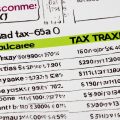Last Updated on: 11th September 2025, 12:34 pm
Have you received a message or email from HMRC saying you have a business tax account and wondered why? You’re not alone. Many business owners across the UK find themselves surprised to learn they already have one set up.
Whether you’re self-employed, running a limited company or just registered a business for tax purposes, it’s likely an account was automatically created for you. This digital tool, provided by HMRC, is designed to simplify tax management, but its functions and purpose aren’t always clear to new users.
In this guide, we’ll break down everything you need to know about why you have a business tax account, how it works, and how it benefits your business.
From understanding its features to managing different taxes, you’ll learn how to make the most of your account and stay on top of your obligations with confidence.
What Is a Business Tax Account?

A business tax account is a secure online portal that consolidates your business taxes in one place. It’s available to individuals, sole traders, partnerships, and limited companies. The account is often set up automatically when you register your business or sign up for specific taxes like VAT, PAYE, or Corporation Tax.
You likely have a business tax account if:
- You registered your business with HMRC
- You enrolled for Self Assessment or VAT
- Your accountant or agent registered taxes on your behalf
- You created a Government Gateway ID linked to a business
When setting up a business tax account, HMRC uses your Government Gateway ID to link services. If you’ve registered for even one business tax, the system may have automatically created the account. It allows you to see your tax status, file returns, and receive secure messages from HMRC all in one dashboard.
The reason you have one is simple: it’s a centralised way for HMRC to manage digital tax compliance, especially with the government’s move toward Making Tax Digital.
What Can You Do With Your Business Tax Account?
Once inside your business tax account, you’ll find several essential features designed to help you manage your tax responsibilities efficiently. These features are tailored to make handling taxes less complex and more organised.
Key tasks you can perform:
- View your business’s overall tax position
- File returns for VAT, Corporation Tax, PAYE, and Self Assessment
- Make payments or set up Direct Debits
- Track payments made and refunds due
- Monitor late payment interest or penalties
- View upcoming tax deadlines and amounts owed
Each tax registered appears as a separate tax card on your homepage. These cards display your reference numbers, filing statuses, and balances. You can access deeper tax-specific information from each card, helping you stay informed and compliant.
Your account also provides:
- Paperless notification options
- Secure messaging from HMRC
- Visibility over pending returns and deadlines
This all-in-one dashboard eliminates the need for multiple logins and keeps your business tax duties in one organised location.
How Did You Get a Business Tax Account?

If you’ve found out you have a business tax account without intentionally setting one up, there are several common explanations. In most cases, registering for a business tax triggers the creation of your account automatically.
You may have a business tax account if:
- You registered as self-employed or formed a limited company
- You enrolled for VAT or Corporation Tax
- Your accountant or agent submitted tax registrations using your details
- You created a Government Gateway ID for your business
Additionally, using HMRC’s online services or submitting tax forms online typically requires a Government Gateway login. If you have one, it’s likely linked to a business tax account by default.
Sometimes users forget that they registered or set up a Government Gateway ID years ago. You can recover your details by following HMRC’s reset process if needed. Always ensure you’re using the same login ID to view all your taxes, as multiple IDs can separate your information unintentionally.
How Can You Access and Use Your Business Tax Account?
Accessing your business tax account is straightforward, but it requires the correct credentials. You’ll need your Government Gateway user ID and password to log in to HMRC’s online services. If you’ve forgotten your details, you can reset them using the recovery options.
How Can You Use the Account?
- Log in via the HMRC online services homepage
- Use your Government Gateway ID and password
- Enable multi-factor authentication for added security
Once logged in, you’ll see a summary of your business’s tax obligations. Each tax card offers access to specific services related to that tax. For example, selecting your VAT card allows you to view return periods, make payments and file VAT returns.
What Are Some Useful Features That Are Included?
- Manage Account: Add or remove taxes, update contact info, manage security settings
- Messages: Securely communicate with HMRC
- Help & Contact: Get detailed help articles and contact support if needed
It’s important to use only one Government Gateway ID for all your tax services. If your tax cards are missing, you may be using the wrong login credentials.
What Are the Benefits of Having a Business Tax Account?

There’s no legal obligation to use a business tax account, but the advantages it offers are substantial. It simplifies tax management, enhances compliance, and reduces the chances of missed deadlines or errors.
Major benefits include:
- One portal for all taxes: Access Self Assessment, Corporation Tax, VAT, and PAYE in one place.
- Faster communication: Receive secure messages and alerts directly from HMRC.
- Real-time tracking: Monitor your payments, refunds, and liabilities as they happen.
- Paperless efficiency: Opt-in for email alerts and reduce paperwork.
- Delegation support: Authorise team members or agents to manage your taxes.
By having all your tax responsibilities visible and accessible, it reduce confusion and saves time. Especially for businesses handling multiple tax types, the account helps centralise everything.
In addition, you’ll avoid common penalties by having reminders and access to detailed filing and payment history. It’s especially useful for businesses preparing for Making Tax Digital, which requires more online interaction with HMRC.
How Do You Set Up or Update Your Account If Needed?
Setting up your business tax account involves just a few steps, and it’s often automatic when you register for a tax. However, if you need to update it or start fresh, the process is straightforward.
Steps to set up or update your account:
- Register for a business tax such as VAT, PAYE, or Corporation Tax
- Create a Government Gateway ID (if you haven’t already)
- Add the tax you want to access using your login
- Wait for an Activation Code from HMRC (typically 7 to 10 days)
To update existing account settings, you can:
- Change contact details such as address, email, or phone number
- Update your Government Gateway password or recovery word
- Manage security settings, including multi-factor authentication
You can also:
- Give team members access to certain tax cards
- Add or remove an accountant or tax agent
- Change your paper notification preferences to paperless
Using the ‘Manage Account’ section gives you control over your business tax setup and helps you stay aligned with your filing obligations.
What If You Want to Remove a Tax From Your Account?

There may come a time when a specific tax no longer applies to your business. Fortunately, your business tax account allows you to remove or stop access to any tax service.
Two main options:
- Deregister: If your business is no longer liable for a tax, such as VAT or PAYE, you can deregister completely. This stops the obligation to file future returns.
- Stop Access: You can remove the tax from your account without deregistering. You won’t see updates in your dashboard, but the tax is still active.
Even if you stop access, your data is still safely stored in HMRC’s system. You can re-add the tax later if needed using your Government Gateway credentials and reference numbers.
To remove a tax:
- Visit the ‘Manage Account’ menu
- Select the tax you wish to remove
- Follow the prompts to either stop access or deregister
- Confirm any required details
Removing unused taxes keeps your dashboard clean and helps you focus on active obligations only.
Common Questions Around Business Tax Account Use
Business tax accounts come with powerful features, and it’s normal to have questions as you begin using them. Many users wonder how to add services, ensure security, or manage their team efficiently.
Here are a few helpful tips:
- To add PAYE, VA,T or Corporation Tax, you’ll need your reference numbers and the date you registered
- Some services require an activation code sent by post, so don’t worry if you can’t access it immediately
- You can assign team members to specific tax duties by adjusting user permissions
- Tax agents can also be added using their agent code or login ID for streamlined collaboration
Security is also a priority. Business tax accounts use multi-factor authentication to protect your information. If you suspect any suspicious activity, you should report it immediately. The account also enables paperless messaging, making communication with HMRC more direct and efficient.
Conclusion
Your business tax account isn’t just a digital requirement; it’s a central hub that simplifies how you manage your tax responsibilities.
If you’ve found yourself wondering why you have one, the answer lies in your registration for any business tax. From Self Assessment to VAT, registering for these services often triggers the account setup automatically.
By using the tools and services provided through your account, you can handle your tax affairs more efficiently. From submitting returns to authorising team members or agents, everything you need is under one login.
Keeping it updated and monitored helps you avoid penalties, meet deadlines and stay fully compliant with HMRC’s expectations. Take full advantage of your account to stay ahead of your business tax obligations today.
FAQs
Can I have more than one business tax account?
No, but you can have multiple Government Gateway IDs. It’s best to use only one ID to access all your taxes.
How do I add a new tax to my account?
You can use the Manage Account section and select Add a tax, duty, or scheme. You’ll need your reference number to complete the process.
What if I forget my Government Gateway login?
You can recover your user ID or reset your password using the HMRC login page. Make sure to have your recovery word or email ready.
Can I give my accountant access to my tax account?
Yes, you can add them as an agent using their agent code. Once authorised, they can manage your taxes on your behalf.
Is the business tax account safe to use?
Yes, it includes multi-factor authentication and encryption. Always keep your login details secure to avoid unauthorised access.
Will removing a tax delete my records?
No, your data remains in HMRC’s system even if you stop access. You can re-add the tax anytime.
Why did I receive an activation code in the post?
HMRC sends this code to verify your identity when adding new services. It’s required before you can access certain tax features.




















No Comments
Leave a comment Cancel